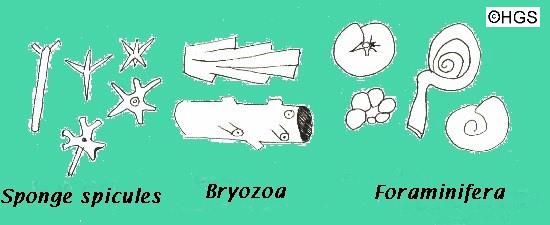

Humberside Geologist no. 10
Flint Meal
by Mike Horne
Sometimes you can find a white or cream coloured soft powdery chalk inside flints. It is known to geologists as "flint meal". I have only seen it inside black flints and even then it is very rare and there is not a lot of it. I have never seen any inside any in situ Yorkshire flints, but I have found it in the Chalk of Coniacian and Santonian age in the south of England and in the soft chalks of Norfolk of late Campanian and Maastrichtian age. I have also found flint meal inside some erratic black flints on the Holderness coast. These erratic black flints are of a similar late Campanian to early Maastrichtian age to the chalk "rafts" which can sometimes be seen in the cliffs.
The powdery flint meal is rich in microfossils. There are more microfossils (over 100 micrometres in size) per unit weight in the flint meal than in the soft chalk, which in turn contains more microfossils than the marl bands. The fossils are much easier to process from the flint meal and their preservation is excellent. Ostracods and planktonic foraminifera are more common and sponge spicules (absent in the marl bands) are preserved. Similar powder can sometimes be found inside hollow echinoids and sponges, but again this is very rare.
What does this "flint meal" represent ?
Well if flints form a few metres below the sediment/water interface at an early stage of diagenesis, as is thought to be the case by many current research workers, then this flint meal must represent sediment trapped within the flint at that depth. It is therefore chalk sediment that has been protected from most of the lithification processes that occur at greater depths, because it has been encased within the flint (or sponge or echinoid).
If this is so, flint meal should have a lot to tell us about diagenesis. Why is the microfauna different ? Why does it only occur in black flints and not in our native grey Yorkshire flints ? Why are the black flints not found in the hard Chalk of the Northern Province ? Are the formation processes different for black and grey flints ?
These are questions that I have never seen answered, but then I have seen few papers that mention flint meal anyway! Perhaps one day the mystery will be solved.

Specimens from flint meal from a black flint from Kilnsea [sample KILN].
Humberside Geologist (1992) no 10, 26.
[click here to visit Mike's microfossil web-site]
copyright Hull Geological Society 2020